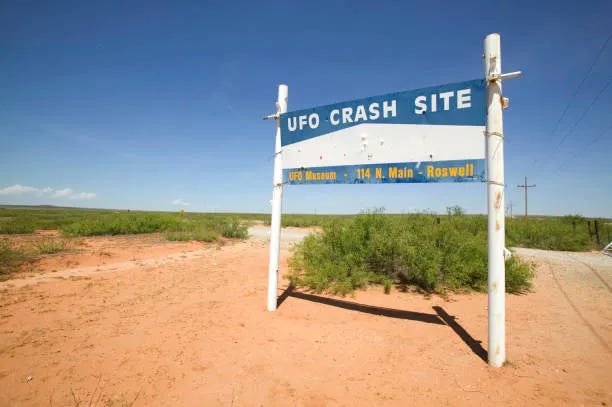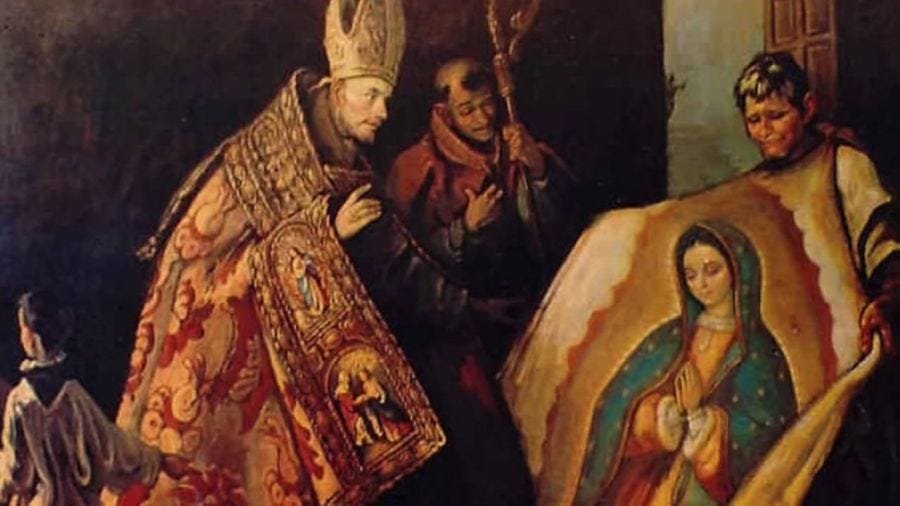Pondering the Unknown and the Invisible: Comparing the Evidence
Tangible evidence is a defining factor in explaining the miraculous or the "unexplained." Here is one case where a miraculous event has more physical proof than certain popular UFO claims.
There is a certain fondness in our current popular culture for analyzing mysterious and strange encounters. It is displayed in modern movies, television shows, books, articles, documentaries, and more recently, even in the mainstream news cycle. What it suggests is that our human minds are at least open to the existence of a reality that is beyond our world and/or the physical realm.
For thousands of years, God and the angels have represented the objective existence of an invisible reality to persons of faith. To others (typically the non-religious), the potential existence of extraterrestrial intelligent life offers an alternative version of that reality, one that differs from our traditional historic understanding. While both groups of believers have many eyewitness accounts to view and consider in support of their beliefs, we know that any information obtained from the experiences of individuals is an extremely limited form of scientific evidence. This is also the case with regards to photographic and video evidence, given that it is subject to interpretation and potential alteration (especially now in the age of AI). Physical (tangible) evidence, on the other hand, the kind that can be seen and touched, is much more relevant in attempting to reach an accurate conclusion.
UFOs/Aliens
Many years ago, strange encounters often involved accounts of visitations by fairies and other mysterious woodland creatures. Today, these accounts have been replaced with reports of alien spacecraft and/or strange alien beings. The existence of alien life forms from other planets has become a relatively popular belief, despite the lack of any significant non-photographic/non-video (i.e., physical) evidence to support it.
One of the most famous and well-known (but not necessarily the first) incidents involving claims of crashed alien spacecraft occurred in Roswell, New Mexico in 1947. During the summer of that year, a local rancher was said to have discovered debris from a crash that was said to be from an alien flying saucer. Later, the materials were claimed to have been confiscated by the U.S. military, thereby removing any potential physical evidence from the public’s view.
Today our modern culture has elevated the town of Roswell to a mecca for alien enthusiasts, and the incident itself to an event of highest significance to those who believe in beings from other planets. Inspired by the incident, numerous movies, television shows and documentaries have been produced to tell the story from various viewpoints, and while these creative works may be entertaining to some (including me), no other-worldly proof, such as an object or piece of debris, has yet been provided from the incident. While alleged eyewitnesses to the Roswell incident have made various claims over the years, there is still no physical (non-photographic/non-video) evidence of any alien technology or any alien beings. Until such evidence is presented, there is nothing for the world to review or analyze.
The Divine/Supernatural
Religion operates as a fundamental dividing line between those who believe in the existence of outer space aliens and those who do not, as religious persons tend to disregard such encounters. At the same time, non-religious persons tend to discount the existence of God and supernatural beings (angels, for example), that according to the Bible, operate in a world that is invisible to us humans and are of Divine origin. In cases where the visible and invisible worlds are found to connect, persons of faith consider these instances to be miraculous.
One of the most famous incidents involving the Divine/supernatural—but one that is not necessarily well-known to the general public at large—is the four appearances of Mary, the mother of Jesus, in 1531 to a man named Juan Diego (now a Saint) near what is today Mexico City. One thing that is unique about the almost 500-year-old incident is that, unlike the Roswell incident, a piece of physical evidence related to it remains in existence today.
The physical evidence, which has come to be known as the image of Our Lady of Guadalupe, is an image that Mary is said to have placed on Juan Diego’s cloak or “tilma.” Some who have seen pictures of it incorrectly consider the image to be a painting that was created by an artist. But this is not the case, and from an evidentiary standpoint, the fact that something tangible was left behind by the Virgin Mary makes it very different from any of the other well-known Marian apparitions.
The image of Our Lady of Guadalupe has provided the world with a specific piece of tangible evidence to ponder, along with many interesting questions. For purposes of scientific inquiry, the most important point to appreciate is that the image provides us with something that can be viewed and studied so that analyses can be conducted, questions can be raised, and conclusions can be drawn.
Here are just a few of the interesting questions that have been raised in relation to the image:
1. Given that microscopic/infra-red/computer-assisted examination has revealed no brush strokes nor paint pigments on the cloak which holds the image (upon testing, the coloring materials were concluded to be neither animal, vegetable, nor mineral dyes, and synthetic coloring was not developed until three centuries later), how was it created, and by what methodology was the image transferred to the cloak? If it is not a painting, what is it?
2. How does a piece of clothing made of natural weaved material—with an expected life of approximately twenty to thirty years—still exist today, given that it is almost five hundred years old, appears to have no sizing/protective varnish, and was kept outside unprotected in the elements for its first one hundred years (where it was touched by millions of hands and lips)?
3. Given that the image appears on ayate fiber made from the agave plant (which is a succulent, but not a cactus given that it has leaves), why does the side of the cloak containing the image appear as if it is made of silk? What scientific theory can be used to explain this?
4. How did the image manage to survive an accident in 1791 when a workman cleaning the gold and silver frame accidentally spilled a bottle of nitric acid on it, which did not destroy any of the delicate fabric, but only left a barely discernable watermark on the material?
5. How did the image survive an intentional attempt to destroy it in 1921, when a bomb concealed in a large vase of flowers placed underneath it was detonated, which did not even crack the single thin pane of glass that was protecting the image at the time, but yet managed to break the stained glass windows of the Basilica, and even twisted a heavy bronze/iron cross that sat on the altar nearby?
6. By what technology/means have microscopic images been embedded in Mary’s eyes (which were concealed for over four hundred years, and not discovered until 1929), and that when viewed in 1956 using an ophthalmoscope appear to be similar to the way that images appear in the human eye? How could anyone paint images so small? In addition, how could a potential human creator of the image have known about corneal eye reflections in 1531, which were not given scientific verification until the 1880s?
These are just a few of the questions that have been, and will continue to be, considered using scientific analysis. Admittedly, mere questions in and of themselves do not prove the existence of God, of the Virgin Mary, or of the supernatural world, but there is no denying that the image itself does exist. At a minimum, the image remains as evidence which points to something that appears to surpass the power of normal human beings.
Conclusion
Sometimes truth is revealed in profound mysteries and through simple events. Truth can also be revealed scientifically through the analysis of physical evidence. While some continue to seek proof of the existence of beings from other planets, the world currently lacks any tangible support for such a conclusion. Nevertheless, many are eager to believe in aliens despite the lack of clear evidence. On the other hand, the image of Our Lady of Guadalupe provides a direct piece of physical evidence for us to ponder regarding proof of the Divine/supernatural. As over eight million Aztecs were converted to the Christian faith as a result of Mary’s appearance to Juan Diego in 1531, there is no doubt it was a significant historic event. But whether the image, from a scientific perspective, offers the world proof of the Divine/supernatural, such a profound conclusion will be up to each and every individual to determine for themselves.
For anyone that is skeptical of the claims regarding the image, I urge them to join the millions of pilgrims who show up each year in Mexico City at the Basilica of Our Lady to view the evidence that many believe was left behind by Our Blessed Mother.
As for those seeking evidence of aliens, they can continue watching the sky…
Photo Credit: Getty Images, Fish Eaters, and National Catholic Register.







The Tilma of Our Lady of Guadalupe is truly a marvel. I’m not sure why it doesn’t get comparable attention to the Shroud of Turin. Instead we bother with stupid alien talk.
We believe what we want to believe most of the time. Skeptics are complete hypocrites in this regard.
Why not? Why would God reveal himself exclusively to the people of the Middle East and Europe? Surely he had mercy on inhabitants of North America also.
Interesting article.